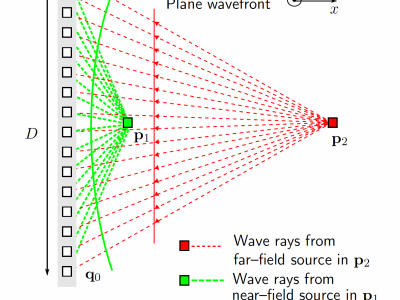Documents
Presentation Slides
Near-field Tracking with Large Antenna Arrays: Fundamental Limits and Practical Algorithms

- Citation Author(s):
- Submitted by:
- Anna Guerra
- Last updated:
- 5 May 2022 - 3:41am
- Document Type:
- Presentation Slides
- Document Year:
- 2022
- Event:
- Presenters:
- Anna Guerra
- Paper Code:
- 9288
- Categories:
- Log in to post comments
Applications towards 6G have brought a huge interest towards arrays with a high number of antennas and operating within the millimeter and sub-THz bandwidths for joint communication, sensing, and localization.
With such large arrays, the plane wave approximation is often not accurate because the system may operate in the (radiating) near-field propagation region (i.e., the Fresnel region) where the electromagnetic field wavefront is spherical.
In this case, the CoA is a measure of the spherical wavefront that can be used to infer the source position using only a single large antenna array.
In this paper, we study a near-field tracking problem for inferring the state (i.e., the position and velocity) of a moving source with an ad-hoc observation model that accounts for the phase-difference profile of a large receiving array. For this tracking problem, we derive the P-CRLB, and we provide insights on how the loss of positioning information outside the Fresnel region results from an increase of the ranging error rather than from inaccuracies of angular estimation. Then, we investigate the accuracy and complexity performance of different Bayesian tracking algorithms in the presence of model parameter mismatches and abrupt trajectory changes. Our results demonstrate the feasibility and high accuracy of most tracking approaches without the need for wideband signals and of any synchronization scheme.

